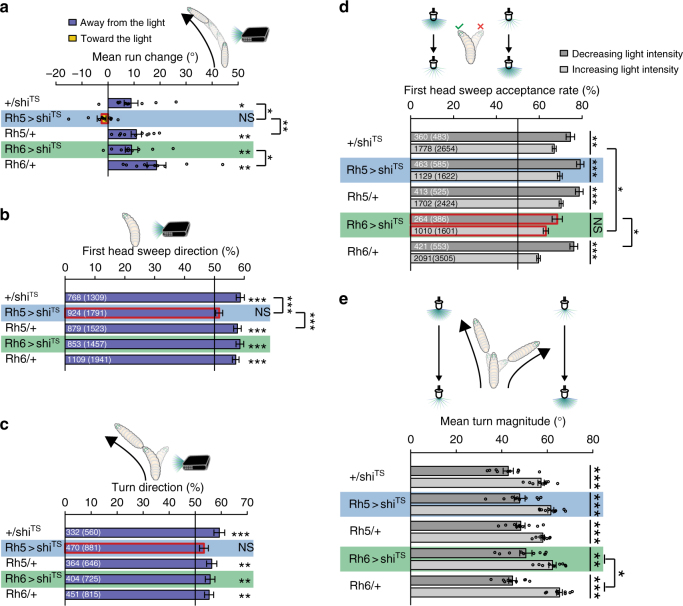Fig. 4.
Function of the two PR subtypes in phototaxis. a Rh5-PRs are necessary to steer away from the light. +/shiTS: n = 10, p = 0.011; Rh5 > shiTS: n = 10, p = 0.1844; Rh5/+: n = 10, p = 0.0015; Rh6 > shiTS: n = 10, p = 0.0078; Rh6/+: n = 10, p = 0.0015. Larvae with silenced Rh5-PRs show a decreased steering away from the light compared to controls. One-way ANOVA: p = 3.0 × 10−5. Dunnett’s test: Rh5 > shiTS vs +/shiTS: p = 0.0122; Rh5 > shiTS vs Rh5/+: p = 0.0024; Rh6 > shiTS vs +/shiTS: p = 1; Rh6 > shiTS vs Rh6/+: p = 0.0412. b Functional Rh5-PRs are necessary to bias the first head sweep direction. +/shiTS: n = 1309, p = 6.3 × 10−10; Rh5 > shiTS: n = 1791, p = 0.1857; Rh5/+: n = 1523, p = 2.4 × 10−9; Rh6 > shiTS: n = 1457, p = 3.7 × 10−10; Rh6/+: n = 1941, p = 6.3 × 10−10. Only the probability of the first head sweep direction of larvae lacking functional Rh5-PRs was statistically different from the controls. Rh5 > shiTS vs +/shiTS: p = 3.7 × 10−4; Rh5 > shiTS vs Rh5/+: p = 9.3 × 10−4; Rh6 > shiTS vs +/shiTS: p = 0.9692; Rh6 > shiTS vs Rh6/+: p = 0.5597. c Larvae lacking functional Rh5-PRs are not able to bias the direction of their turns away from the light source. +/shiTS: n = 560, p = 6.4 × 10−5; Rh5 > shiTS: n = 881, p = 0.0506; Rh5/+: n = 646, p = 0.0032; Rh6 > shiTS: n = 725, p = 0.0032; Rh6/+: n = 815, p = 0.0032. Rh5 > shiTS vs +/shiTS: p = 0.1182; Rh5 > shiTS vs Rh5/+: p = 0.3369; Rh6 > shiTS vs +/shiTS: p = 0.3369; Rh6 > shiTS vs Rh6/+: p = 0.9182. d Functional Rh6-PRs are necessary for accepting more head sweeps during a decrease than increase of light intensity. +/shiTS: n = 3137, p = 0.0012; Rh5 > shiTS: n = 2207, p = 1.9 × 10−5; Rh5/+: n = 2949, p = 1.3 × 10−4; Rh6 > shiTS: n = 1987, p = 0.0513; Rh6/+: n = 4058, p = 1.6 × 10−13. Rh5 > shiTS vs +/shiTS (intensity decrease): p = 0.1060; Rh5 > shiTS vs +/shiTS (intensity increase): p = 0.1264; Rh5 > shiTS vs Rh5/+ (intensity decrease): p = 0.8829; Rh5 > shiTS vs Rh5/+ (intensity increase): p = 0.8003; Rh6 > shiTS vs +/shiTS (intensity decrease): p = 0.0974; Rh6 > shiTS vs +/shiTS (intensity increase): p = 0.0414; Rh6 > shiTS vs Rh6/+ (intensity decrease): p = 0.0414; Rh6 > shiTS vs Rh6/+ (intensity increase): p = 0.0548. e Each PR subtype alone is sufficient to perform greater turns during the phase of light intensity increase than during the phase of light intensity decrease. +/shiTS: n = 10, p = 8.6 × 10−5; Rh5 > shiTS: n = 10, p = 1.4 × 10−4; Rh5/+: n = 10, p = 2.0 × 10−4; Rh6 > shiTS: n = 10, p = 0.0015; Rh6/+: n = 10, p = 4.3 × 10−8. We compared the turn magnitude delta of experimental and control lines. One-way ANOVA: p = 0.0201. Dunnett’s test: Rh5 > shiTS vs +/shiTS: p = 0.998; Rh5 > shiTS vs Rh5/+: p = 0.575; Rh6 > shiTS vs +/shiTS: p = 0.83; Rh6 > shiTS vs Rh6/+: p = 0.03. a–e In the graphs only statistically significant differences between experimental groups and their respective controls are indicated for simplicity. The data are mean ± SEM. a, e One sample t-test was used. Circles are means of individual experiments. b, c Exact binomial and b–d Fisher’s exact test were applied. a–e Benjamini Hochberg procedure was used. b, c The first number gives the number of first head sweeps or turns, respectively, directed to the indicated direction and the number in brackets is the total number of events. d The first number is the number of accepted first head sweeps and the number in brackets is the number of all first head sweeps. *p < 0.05, **p < 0.01, ***p < 0.001, n = not significant

